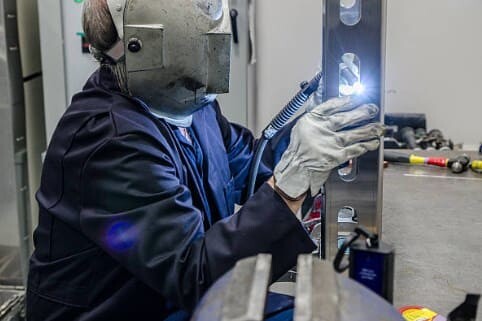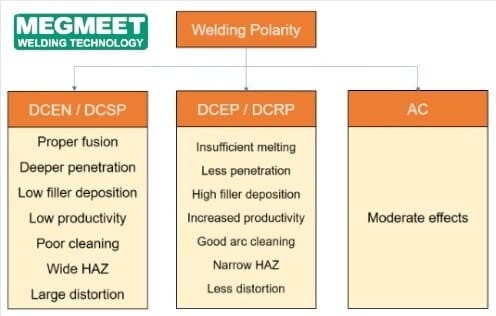Polarity in welding refers to the direction of electrical flow between the welding power source, electrode, and workpiece. It plays a crucial role in determining the weld characteristics, penetration depth, and overall welding process. In this comprehensive guide, we'll explore the basics of polarity and its significance in different welding techniques.

I. What is Polarity in Welding?
1) Types of Polarity
Direct Current (DC): DC welding machines offer two types of polarity – direct current electrode negative (DCEN) and direct current electrode positive (DCEP).
Alternating Current (AC): AC welding involves a constant change in polarity, alternating between positive and negative.
2) Electrode and Workpiece Interaction
DCEN (Electrode Negative): In DCEN, electrons flow from the workpiece to the electrode. This polarity results in deeper penetration and more heat concentrated in the workpiece.
DCEP (Electrode Positive): With DCEP, electrons flow from the electrode to the workpiece. This polarity provides better arc stability and improved electrode life but offers shallower penetration compared to DCEN.
AC Polarity: Alternating current polarity combines the advantages of both DCEN and DCEP. It facilitates a balance between good arc stability and reasonable penetration.
II. Importance of Polarity in Welding Processes
The importance of polarity in welding processes cannot be overstated, as it significantly influences the quality, characteristics, and effectiveness of welds. Understanding and selecting the right polarity is crucial for achieving optimal results in various welding techniques. Here's a breakdown of its significance in different welding processes:
1) Shielded Metal Arc Welding (SMAW)
DC Polarity for Deep Penetration: In SMAW or stick welding, using a Direct Current Electrode Negative (DCEN) facilitates deeper penetration into materials like steel. This polarity allows for better control over heat input and weld penetration, which is vital for creating strong and durable welds.
2) Gas Tungsten Arc Welding (GTAW/TIG)
Polarity Impact on TIG Welding: TIG welding often employs Direct Current Electrode Positive (DCEP) polarity. This setting provides improved arc control and stability, which is especially beneficial when working with thinner materials. It contributes to a better weld bead appearance and control over the welding process.
3) Flux-Cored Arc Welding (FCAW)
The choice of polarity significantly affects the welding arc, heat distribution, and weld characteristics. DCEN generally offers deeper penetration, ideal for thicker materials, while DCEP provides better arc stability, suitable for thinner materials and intricate welds.
III. How To Choose The Right Polarity In Welding?
Selecting the appropriate polarity depends on factors like material thickness, welding technique, and desired weld characteristics.
Material Thickness: Thicker materials often benefit from DCEN for deeper penetration, while thinner materials may require DCEP for better control and reduced burn-through.
Welding Technique: Different techniques, like weaving or stringer beads, might perform better with specific polarities. Experimentation helps identify the ideal polarity for a given technique.
Desired Weld Characteristics: Consider the desired outcome, such as penetration depth, bead appearance, and overall weld quality, to determine the suitable polarity.
IV. Welding Polarity Recommendations for TIG, MIG, And Stick.

1) TIG Welding Recommendations
2) MIG Welding Recommendations
3) Stick Welding Recommendations
Conclusion
Understanding polarity's impact on welding is crucial for achieving high-quality welds across different techniques. Selecting the right polarity enhances control, penetration, and overall weld quality.
Related articles:
1. Laser Welding vs MIG Welding: the Basics
2. The Most Complete TIG Welding Basics
3. Complete Basics of Gas Shielded Arc Welding
4. Automatic Welding Machine Basics You Must Know
5. What are the 4 Basic Welding Positions and How to Choose the Right One?





